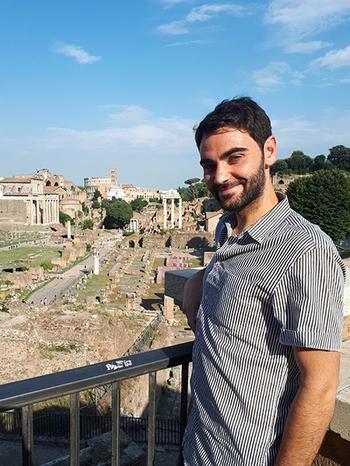Vincenzo Timpano M.A.

Landscape Archaeology and Architecture (LAA)
Klassische Archäologie
Akademische Ausbildung
10/2021 – 12/2021
Gastsemester an der University of Oxford, im Michaelmas Term 2021
04/2018 – 12/2024
PhD student in Classical Archaeology at the Humboldt Universität zu Berlin
12/2016 – 05/2017
Erasmus - Thesis research at the Humboldt Universität zu Berlin
11/2014 – 07/2017
Specializzazione in Classical Archaeology (cum laude), University of Basilicata - Matera (postgraduate School of Archaeology)
09/2012 – 05/2014
Master of Arts in Archaeology (cum laude), University of Calabria
09/2007 – 02/2012
Bachelor of Arts in Cultural Heritage, University of Calabria
Archäologische Grabungen und Surveys
2012 – in progress
S. Omobono excavation project, Rome
2018
Palatine Hill - northern slopes, Rome
2015 – 2016
Temple of Apollo and extra-urban temple of Ex Fondo Iozzino, Pompeii
2015
Chora survey project, Eraclea Lucana
2009 – 2011
Torre Inferrata excavation project, Calabria
The Archaeology of Ritual in Early Rome. Investigating the role of ritual practices in the life cycles of sacro-political places
Based on a sample of 107 archaeological assemblages from various sacred / sacro-political sites, this thesis investigates the significance of ritual behaviour within a defined socio-cultural, geographical, and chronological framework, i.e. Rome during the Orientalising and Archaic periods (late 8th – mid-5th cent. BC). Through the contextual analysis of remains of ritual practices - their archaeological realia - within their respective sacred areas / cult buildings, the study contributes to a deeper understanding of the (im)material dimension of early Roman religion. It addresses a significant gap in scholarship, shaped in part by the absence of contemporary written sources for this period. The identification of these contexts as ‘ritual’ is based on a context-specific methodology, developed through a critical review of theoretical and methodological approaches within the archaeology of ritual. This analytical framework enables the attribution of a defined ritual significance to the archaeological contexts, thus facilitating the discernment of the motivation behind their existence. The analysis demonstrates a strong correlation between ritual behaviours and key moments in the life cycle of sacred areas / cult buildings, such as foundation, abandonment, structural modifications, each marked by distinct ritual practices; additionally, although to a lesser extent, the evidence reflects patterns of routine participation in ritual activity.
In preparation
E. Lundius, V, Timpano (eds.), The Archaeology of Ritual. Rethinking Ritual Practices in Sanctuaries and Necropoleis of the ancient Mediterranean World, International Workshop, Humboldt Universität, Berlin 7th – 8th February 2020.
Burying the sacred. Archaeology of ritual depositional practices in archaic Rome in: E. Lundius, V. Timpano (eds.), The Archaeology of Ritual. Rethinking Ritual Practices in Sanctuaries and Necropoleis of the ancient Mediterranean World, International Workshop, Humboldt Universität, Berlin 7th – 8th February 2020.
In press
Area sacra di S. Omobono (Roma). Scansione crono-tipologica degli apparati decorativi (ultimo quarto del VII - fine VI sec. a.C.), in: P. Brocato, N. Terrenato (a cura di), Ricerche nell’area dei templi di Fortuna e Mater Matuta (Roma) III.
Contributo allo studio dei sistemi di copertura di età tardo-orientalizzante ed arcaica dall’area sacra di S. Omobono a Roma, in: P. Brocato, N. Terrenato (a cura di), Ricerche nell’area dei templi di Fortuna e Mater Matuta (Roma) III.
2019
Elementi architettonici e di copertura, schede A.2-7, A.9; Plastica figurata a tutto tondo, schede B.2-4; Elementi di incerta interpretazione, schede E.2, E.4, in: I. Damiani, C. Parisi Presicce (a cura di), La Roma dei Re. Il racconto dell’archeologia. Catalogo della mostra (Roma, Musei Capitolini, 27 luglio 2018 – 2 giugno 2019), Roma 2019, 65-82, 96-98.
2018
Elementi di copertura dei tetti, in P. Brocato, Lo scavo nella cella del tempio ovest (saggio A7) in: P. Brocato, M. Ceci, N. Terrenato (a cura di), Ricerche nell’area dei templi di Fortuna e Mater Matuta (Roma) II, 121-122.
2016
Il settore 4 della Regia: analisi della sequenza stratigrafica, in: P. Brocato – N. Terrenato (eds.), Nuovi studi sulla Regia di Roma, 57-70.
Per un riesame del sistema di copertura della Regia tra l’età arcaica ed alto repubblicana, in: P. Brocato, N. Terrenato (a cura di), Nuovi studi sulla Regia di Roma, 139-147.
Contesti di provenienza dei reperti architettonici del tempio arcaico di S. Omobono, in: P. Brocato – M. Ceci – N. Terrenato (eds.), Ricerche nell’area dei templi di Fortuna e Mater Matuta (Roma) I, 21-30.
Aspetti iconografici e cultuali dal tempio arcaico di S. Omobono, in: P. Brocato – M. Ceci – N. Terrenato (eds.), Ricerche nell’area dei templi di Fortuna e Mater Matuta (Roma) I, 77-81.
